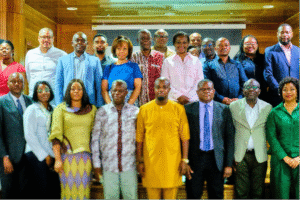
Photo: Emmanuel Kofi Armah Buah, Minister for Lands and Natural Resources
• But the Ministry Gives Itself 8.5/10 for the Fight
New research from the Ghana Institute of Foresters suggests the scale of illegal mining inside the country’s protected areas is significantly larger than official briefings have indicated, with 50 reserves now recorded as compromised by galamsey activity.
The institute told its 28th annual general meeting in Kumasi on 6 November 2025 that its field teams had confirmed incursions into 49 forest reserves and one wildlife reserve. The finding contrasts with a recent statement to Parliament by the Lands and Natural Resources Minister, Armah Kofi Buah, who reported that 44 of Ghana’s 288 forest reserves had been encroached and that nine of those had been recovered.
At the meeting, foresters urged urgent action. “The evidence from the field is clear. Mining has moved deeper into protected zones and is degrading habitats that are vital for biodiversity and water security,” the institute said in its presentation.
Dr Hugh Brown, Chief Executive of the Forestry Commission, told delegates that foresters on the front line face constant danger while trying to curb illegal operations. He paid tribute to field officers and called for strengthened protections. “Our foresters remain resolute in the fight against mining in our forest reserves. We salute you, our unsung heroes who have demonstrated courage in the face of danger,” he said.
The institute singled out several severely affected areas, including Apamprama Forest Reserve in the Ashanti Region, the Offin Shelterbelt and the Tano Anwia Forest Reserve. These landscapes are known not only for their biological value but also for the role they play in safeguarding river systems and community water supplies. The meeting heard disturbing reports that officers attempting to halt illegal mining operations have been killed or seriously injured.
The data presented also highlighted systemic weaknesses in enforcement and prosecution. Of 1,190 arrests for illegal mining recorded between 2023 and October 2025, officials have succeeded in prosecuting only 35 cases. That low conviction rate has fuelled concern that weak deterrents and the influence of well-resourced mining syndicates are undermining efforts to protect forests.
The Forestry Commission urged a threefold response. First, it called for new legislation to replace L.I. 2462 and L.I. 2501 with a stronger legal framework that would permit only tightly controlled mining in designated production forests while keeping protected reserves entirely off-limits. Second, it asked the government to restore the policy of destroying excavators and other heavy equipment seized inside forest reserves, arguing the measure had previously disrupted illegal operations. Third, it proposed a national restoration programme to rehabilitate lands degraded by mining alongside a public education campaign on the environmental and social costs of galamsey.
Environmental organisations welcomed the foresters’ report and warned that a widening gap has opened between official reporting and what is happening on the ground. “Without coordinated action, Ghana risks permanently losing some of its most important ecological assets and undermining livelihoods that depend on functioning watersheds,” one group said.
The Lands Ministry responded obliquely. Paa Kwesi Schandorf, the ministry’s media relations officer, rated the government’s performance in the fight against galamsey at 8.5 out of 10, a score that will be difficult to reconcile with the foresters’ tally and the low prosecution rate.
The divergence between the institute’s findings and the ministry’s assessment raises immediate questions for policymakers. Experts say reconciling field intelligence with parliamentary briefings will be crucial if the state is to mount an effective, coordinated response.
Restoration and law enforcement will require sustained funding, interagency cooperation and the political will to confront well-financed syndicates that profit from illicit mining. Without those elements, the foresters warned, the problem will continue to spread, with long-term consequences for water security, food production and biodiversity.
The Forestry Commission says it will publish more detailed field reports in the weeks ahead and has called on Parliament to consider its legislative proposals with urgency.






